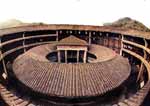 |
Hakka's Earthen Buildings Being Prepared for World Heritage List

Hakka's Earthen Buildings Being Prepared for World Heritage List
Yongding County in east China' s Fujian Province has been improving the environment around the earthen buildings inhabited by Hakka people in the province with financing of over 30 million yuan (about US$3.62 million) .
The efforts are being made to prepare Hakka's earthen buildings for their inclusion on the World Heritage List in 2003, said the spokesman for the Yongding County Government at a news briefing specially convened in Beijing Wednesday.
Such efforts include upgrading roads connected to the earthen buildings, hiding TV antennas, telecom cables and high-tension lines beneath the ground, growing more trees, rebuilding sewage discharge facilities, and doing some repairs on the earthen buildings, said the spokesman.
The Hakka people are offspring of the Han nationalities living in central China who started to migrate to the southeast as early as the Western Jin Dynasty (265-316).
Most of the Hakka people settled in present-day Jiangxi, Fujian, Guangdong, and Taiwan provinces. The Hakka people, refusing to mix with other local ethnic groups, have remained the same in many ways, including their 2,000-year-old traditional language, clothing and customs.
Earthen buildings -- circular or square -- have been preserved as evidence of the Hakka people's keen love for their own tradition. Earthen buildings, some of which are still in use, can accommodate tens of households each.
Chinese experts say that the early Hakka settlers in southeast China developed the earthen buildings because they offered defence against attacks by wild beasts or bandits.
There are some 20,000 square and circular earthen buildings in Yongding County, where some 410,000 Hakka people are now living.
There are currently 630 world heritage sites, among which 27 are in China.
| As early as l,000 years ago, some of the original Hakka who migrated to Shibi continued on to the Yongding area, then still sparsely populated. To protect themselves against bandits and wild beasts, they used local materials to build tall, multi-storey circular earthen buildings where a whole family or clan could live. These buildings were both spacious and practically impregnable, and this unique building style has continued until now. |

In This Section

|